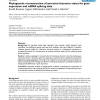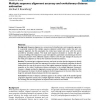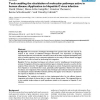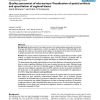136
click to vote
BMCBI
2005
2005
Phylogenetic reconstruction of ancestral character states for gene expression and mRNA splicing data
15 years 27 days ago
Background: As genomes evolve after speciation, gene content, coding sequence, gene expression, and splicing all diverge with time from ancestors with close relatives. A minimum e...
111
Voted
BMCBI
2005
15 years 27 days ago
2005
Background: Sequence alignment is a common tool in bioinformatics and comparative genomics. It is generally assumed that multiple sequence alignment yields better results than pai...
114
Voted
BMCBI
2005
15 years 27 days ago
2005
Background: Evolutionary distances are a critical measure in comparative genomics and molecular evolutionary biology. A simulation study was used to examine the effect of alignmen...
BMCBI
2005
15 years 27 days ago
2005
Background: Probabilistic models for sequence comparison (such as hidden Markov models and pair hidden Markov models for proteins and mRNAs, or their context-free grammar counterp...
131
Voted
BMCBI
2005
15 years 27 days ago
2005
Background: Complete sequencing of bacterial genomes has become a common technique of present day microbiology. Thereafter, data mining in the complete sequence is an essential st...
119
Voted
BMCBI
2005
15 years 27 days ago
2005
Background: The extraction of biological knowledge from genome-scale data sets requires its analysis in the context of additional biological information. The importance of integra...
101
Voted
BMCBI
2005
15 years 27 days ago
2005
Background: Quality-control is an important issue in the analysis of gene expression microarrays. One type of problem is regional bias, in which one region of a chip shows artifac...
120
click to vote
BMCBI
2005
15 years 27 days ago
2005
Background: Ambiguity is a problem in biosequence analysis that arises in various analysis tasks solved via dynamic programming, and in particular, in the modeling of families of ...
113
click to vote
BMCBI
2005
15 years 27 days ago
2005
Background: A large number of papers have been published on analysis of microarray data with particular emphasis on normalization of data, detection of differentially expressed ge...




